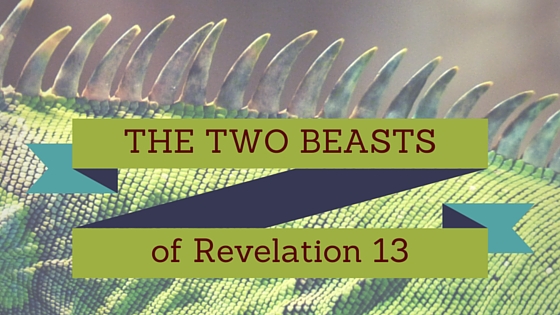Written by Lesallan Bostron
BIB3560 Revelation (ONLSP23)
Ohio Christian University – Pastor Alexander Soultz

Initial Observations & Questions
- There are two beasts mentioned in the Book of Revelation chapter thirteen: one rising from the sea (Revelation 13:1, ESV); and the other from the earth (Revelation 13:11, ESV).
- Who or what are these beasts (Revelation 13:1; 13:11, ESV)?
- What might the heads, horns, and diadems represent (Revelation 13:1; 13:3; 13:11, ESV)?
- What does the beast’s description show us about its nature (Revelation 13:1-18, ESV)?
- Where does the beast get power from (Revelation 13:2, ESV)?
- What does Revelation 13:1-18 (ESV) teach us about how Satan influences this world?
Structure
This chapter of Revelation 13:1-18 describes two beasts, one that rises from the sea (Revelation 13:1, ESV) and the other from the earth (Revelation 13:11, ESV). These beasts represent the political authority that has become destructive. Revelation 13:1-18 (ESV) is part of the larger narrative found in the Book of Revelation that describes how “Satan attacks the church’s perseverance and purity through persecution, deceptive teaching, and the temptations of wealth and sensual pleasure” (Crossway, 2001). At the end of the age, the church’s adversaries will increase their persecution, and Jesus, the triumphant Word of God, will conquer and destroy all His enemies.
The two main sections of Revelation 13:1-18 (ESV) are the first section, Revelation verses 13:1-10 (ESV). This first section describes the first beast that rises from the sea (Revelation 13:1, ESV) and is given power and authority by the dragon (Revelation 13:2, ESV) and is worshiped by the people of the earth (Revelation 13:4, ESV). The second section of this passage is Revelation 13:11-18 (ESV), describing the second beast that rises from the earth (Revelation 13:11, ESV). This second beast performs great signs and deceives the people of the earth (Revelation 13:13-14, ESV). This deception causes the people of the earth to worship the first beast and its image (Revelation 13:12, ESV). In the second section (Revelation 13:11-18, ESV), the second beast also enforces a mark on the people of the earth (Revelation 13:16, ESV), preventing them from buying or selling without it (Revelation 13:17, ESV). The two sections are structurally related as they both describe beasts that are given power and authority by the dragon and are worshiped by the people of the earth. The second beast acts in support of the first beast, enforcing its worship and authority over the people of the earth (Revelation 13:1-18, ESV).
- The First Beast (Revelation 13:1-10, ESV).
A. The beast rises from the sea (Revelation 13:1, ESV).
B. The dragon gives the beast power and authority (Revelation 13:2-4, ESV).
C. The beast blasphemes and makes war on the saints (Revelation 13:5-7, ESV).
D. The beast is worshiped by the people of the earth (Revelation 13:8, ESV).
E. A call for endurance and faith (Revelation 13:9-10, ESV).
- The Second Beast (Revelation 13:11-18, ESV).
A. The beast rises from the earth (Revelation 13:11, ESV).
B. The beast performs great signs and deceives the people of the earth (Revelation 13:12- 14, ESV).
C. The beast enforces worship of the first beast and its image (Revelation 13:15, ESV).
D. The beast enforces a mark on the people of the earth (Revelation 13:16-17, ESV).
E. A call for wisdom and understanding (Revelation 13:18, ESV).
Words & Phrases
“a beast” (Revelation 13:1, ESV).
What does the imagery associated with the “a beast” means to represent or symbolize in Revelation 13:1 (ESV)?
The imagery of the beast rising from the sea with ten horns and seven heads, with ten diadems on its horns and blasphemous names on its heads (Revelation 13:1, ESV) represents a powerful and blasphemous political entity. The dragon gives this beast power and authority (Revelation 13:2, ESV) and represents Satan. The ten horns and seven heads symbolize the beast’s power and authority, while the ten diadems represent its rule over kingdoms. The blasphemous names on its heads (Revelation 13:1, ESV) indicate its opposition to God.
“mortal wound” (Revelation 13:3, ESV).
What does “mortal wound” represent or symbolize in Revelation 13:3 (ESV)?
The term mortal wound usually refers to a wound or injury that is typically fatal. In the case of the beast, the wound has been miraculously healed, which causes the people of the earth to stand in awe and follow the beast (Revelation 13:3, ESV). The healing of the mortal wound has often been interpreted as a counterfeit resurrection, meant to mimic the resurrection of Jesus and deceive the people of earth.
“forty-two months” (Revelation 13:5, ESV).
What does the phrase “forty-two months” (Revelation 13:5, ESV) mean, signify, or refer to?
The phrase “forty-two months” (Revelation 13:5, ESV) refers to a period of time during which the beast is allowed to exercise its authority. The significance of “forty-two months” is first explained in the Book of Daniel chapter nine and then again in the Book of Matthew chapter twenty-four. It is often interpreted as a time of trial or tribulation, and some have interpreted this period as a literal three and a half years, while others see it as symbolic of a more extended period of time.
“another beast” (Revelation 13:11, ESV).
What is the significance of this beast (Revelation 13:11, ESV), and how does it relate to the first beast in Revelation 13:1 (ESV)?
This second of the two beasts that rises from the earth (Revelation 13:11, ESV) is often described as the false prophet. This second beast is closely associated with the first beast that rises from the sea (Revelation 13:1, ESV) and acts in support of it. By performing great signs, the second beast deceives the people of the earth and causes them to worship the first beast and its image (Revelation 13:13-15, ESV). In addition, the second beast forces a mark on the people of the earth and prevents them from buying or selling without the mark (Revelation 13:16-17, ESV). The significance of this second beast is that it represents a religious or spiritual authority that works hand in hand with the political authority represented in the first beast. Both together represent a powerful and deceptive system that opposes God and persecutes His people.
“the mark” (Revelation 13:16, ESV).
Is “the mark” (Revelation 13:16, ESV) literal or symbolic?
This mark is another debate among scholars and theologians as to whether “the mark” (Revelation 13:16, ESV) is meant to be understood as a literal physical mark placed on the right hand or forehead and is required for buying and selling or as a symbolic pledge of allegiance to the first beast and its image.
How has “the mark” in Revelation 13:16 (ESV) been interpreted?
Some have interpreted the mark as a literal physical mark, such as a tattoo or a microchip. Others see “the mark” (Revelation 13:16, ESV) as symbolic of one’s allegiance to the beast and its system. Regardless of what the mark is understood as (literal or symbolic), its significance is in what it represents: allegiance to the beast and opposition to God.
“666” (Revelation 13:18, ESV).
What is the significance of “666” in Revelation 13:18 (ESV)?
This number “666” has been labeled as the number of the beast (Revelation 13:18, ESV) and is also a great matter of debate among scholars and theologians.
What are some common interpretations of “666” (Revelation 13:18, ESV)?
Some interpretations hold that 666 represents imperfection or incompleteness because it falls short of the perfect number, 777 (Hopler, 2022). In the view of Revelation 13:18 (ESV), 666 symbolizes the ultimate imperfection and failure of the beast and its system. Another interpretation of “666” (Revelation 13:18, ESV) is that it represents a specific individual, as the verse states that it is “the number of a man” (Revelation 13:18, ESV). In this interpretation, “666” (Revelation 13:18, ESV) is calculated using gematria. Gematria is a system in which letters are assigned numerical values to identify a specific individual (Hila Ratzabi, 2009). Several historical figures, including Roman Emperor Nero, have been proposed as candidates for this identification. Regardless of specific interpretations, the significance of the number 666 lies in its association with the beast and its opposition to God.
Summary, correlation, & application
Revelation 13:1-18 (ESV) describes two beasts, representing political and religious authority, that oppose God and persecute His people.
In the passage found in Revelation 13:1-18 (ESV), the first beast rises from the sea and is given power and authority by the dragon. The people of the earth worship the first beast, and this beast makes war on the saints (Revelation 13:1-10, ESV). Rising from the earth, the second beast performs great signs, deceives the people of the earth, and causes them to worship the first beast and its image. This second beast also enforces a mark on the people of the earth, preventing them from buying and selling without it (Revelation 13:11-18, ESV). These two beasts represent a powerful and deceptive system that opposes God and persecutes His people.
Revelation 13:1-18 (ESV) relates to other parts of Scripture in several ways. The first example is found in the Book of Daniel, “And four great beasts came up out of the sea, different from one another” (Daniel 7:3-7, ESV). The number “666” (Revelation 13:18, ESV) has also been linked to passages in the Old Testament, “Now the weight of gold that came to Solomon in one year was 666 talents of gold” (1 Kings 10:14; 2 Chronicles 9:13, ESV). Finally, the themes of persecution and endurance found in Revelation 13 (ESV) are echoed in the New Testament, such as in the letter of Paul and Peter. These New Testament letters encourage believers to remain faithful despite suffering and opposition.
When Revelation 13:1-18 is interpreted within its canonical context, this passage can have personal and corporate applications for believers. There are two beasts described that represent political and religious authority and oppose God and persecute His people. These beasts demand worship and allegiance, enforcing a mark on those who comply. Personally, this passage (Revelation 13:1-18, ESV) serves as a reminder always to remain faithful to God and resist the temptation to compromise with the world. The call for endurance and faith in Revelation 13:10 (ESV) encourages persevering in the face of opposition and persecution. This passage can warn against the dangers of aligning with worldly powers and systems that oppose God for the local church, denomination, or churches as a whole. The church is called to remain faithful to its mission of proclaiming the gospel and serving as a witness to the truth, even in the face of opposition.
Further questions
- What is the historical and cultural context of this passage?
- How does this passage apply to believers today, both individually and corporately?
References:
Bauer, D. R. (2014). Inductive bible study – a comprehensive guide to the practice of Hermeneutics. Baker Publishing Group.
Bauer, & Traina. (2022). How to Study Words and Phrases. In https://lms.ohiochristian.edu/d2l/home. https://lms.ohiochristian.edu/
Beale, G. K. (1999). Revelation: a commentary on the Greek text. W.B. Eerdmans.
Beasley-Murray, G. R. (1997). “Revelation, Book of.” In Dictionary of the Later New Testament and Its Developments, edited by Ralph P. Martin and Peter H. Davids, pp. 1025–38. Downers Grove, IL: Intervarsity.
BibleProject. (2021). How to Read the Bible: Apocalyptic Literature. Www.youtube.com. https://www.youtube.com/watch?v=UNDX4tUdj1Y
Book of Revelation – ESV – Bible Study Tools. (n.d.). Biblestudytools.com. https://www.biblestudytools.com/esv/revelation/
Book of Revelation Explained Scripture by Scripture. (2023). Bible-Studys.org. https://bible-studys.org/Discoverrevelation.com/Book%20of%20Revelation%20Explained.html
Crossway. (2001). Introduction to Revelation | ESV.org. ESV Bible. https://www.esv.org/resources/esv-global-study-bible/introduction-to-revelation/#:~:text=Satan%20attacks%20the%20church%E2%80%99s%20perseverance%20and%20purity%20through
Hila Ratzabi. (2009, May 5). What Is Gematria? My Jewish Learning; My Jewish Learning. https://www.myjewishlearning.com/article/gematria/
Hopler, W. (2022, January 24). What Is the Meaning of 777 in the Bible? Crosswalk.com. https://www.crosswalk.com/faith/bible-study/what-is-the-meaning-of-777-in-the-bible.html
Keener, C. S. (2014). The IVP Bible background commentary: New Testament. Intervarsity Press.
LaHaye, T. (2010). Revelation Unveiled. Zondervan.
Logan, C. (2019). English Standard Version – Read Online. Bible Study Tools. https://www.biblestudytools.com/esv/
Mounce, R. H. (1997). The Book of Revelation. W.B. Eerdmans.
Revelation 13 – ESV Bible – Bible Study Tools. (n.d.). Biblestudytools.com. https://www.biblestudytools.com/esv/revelation/13.html



